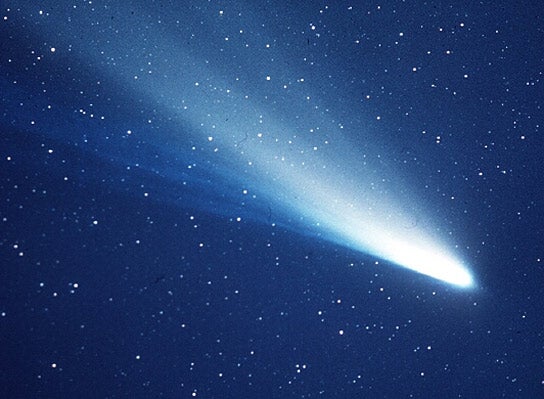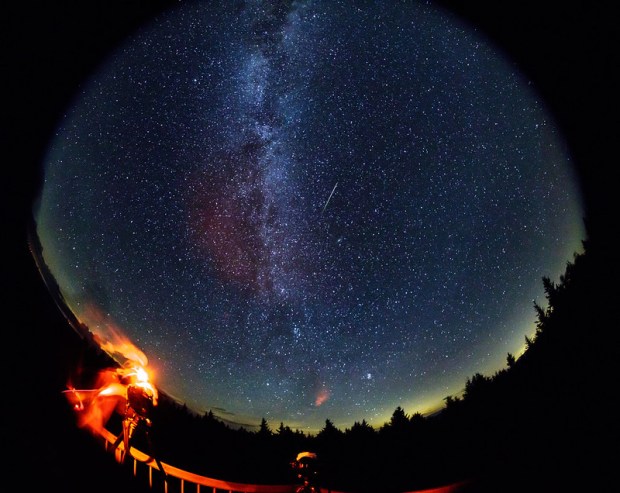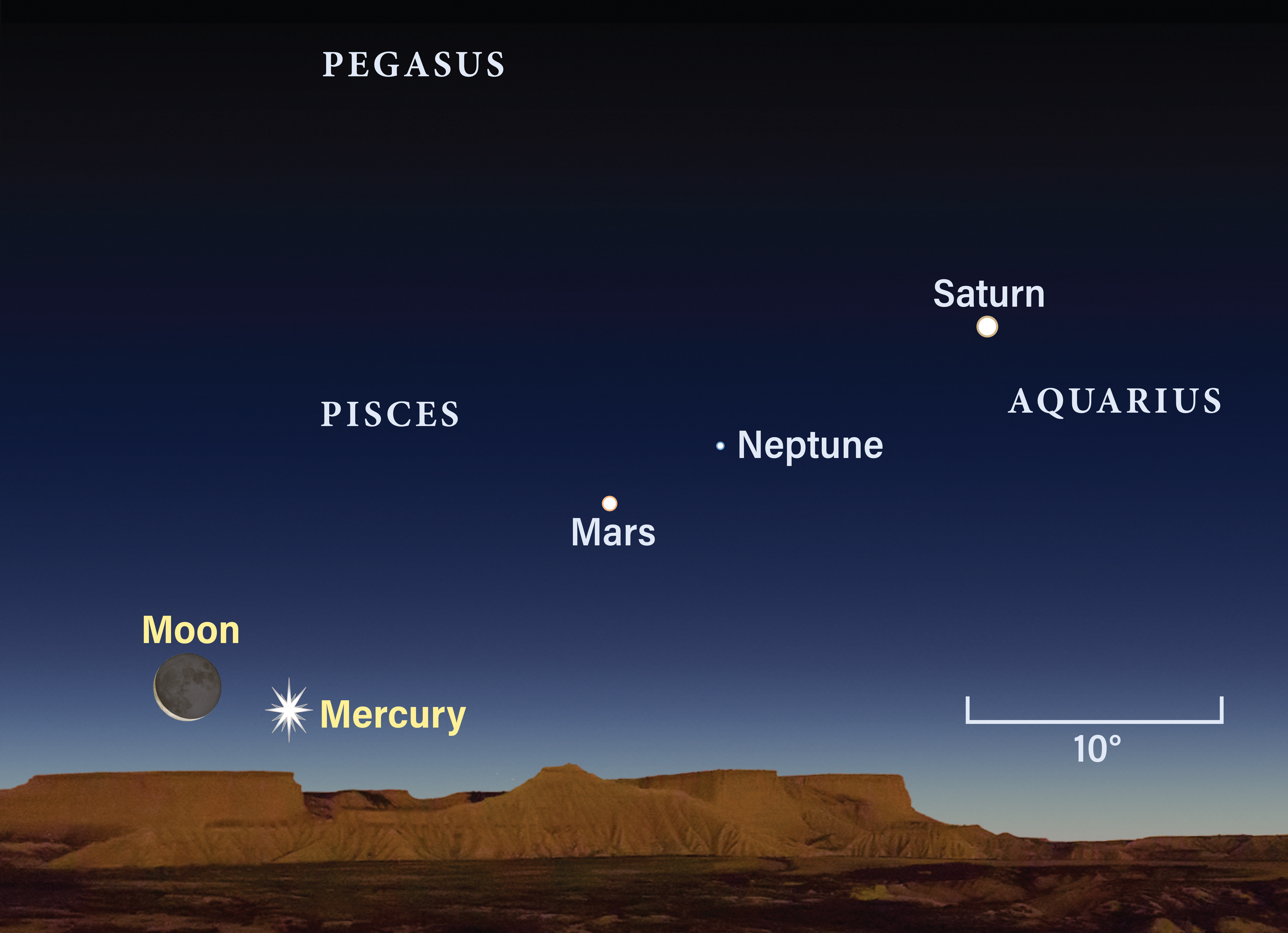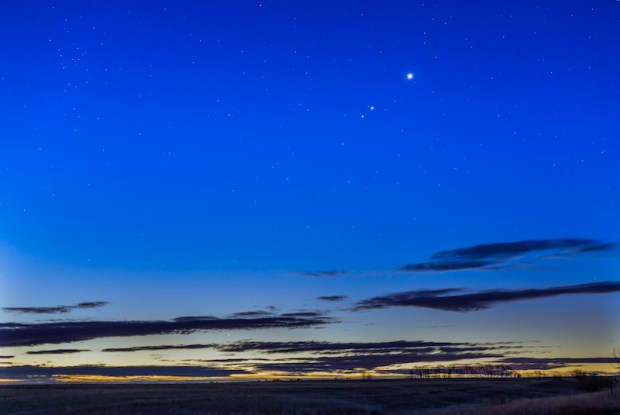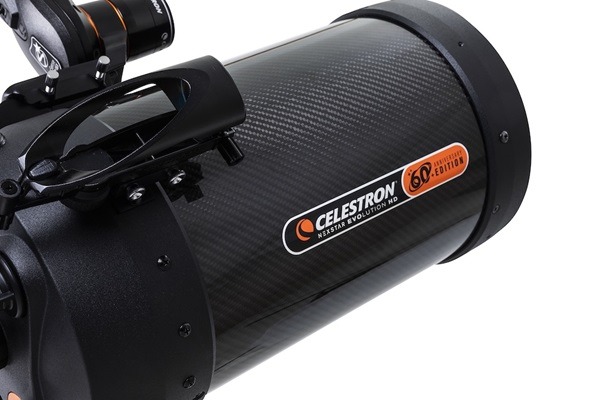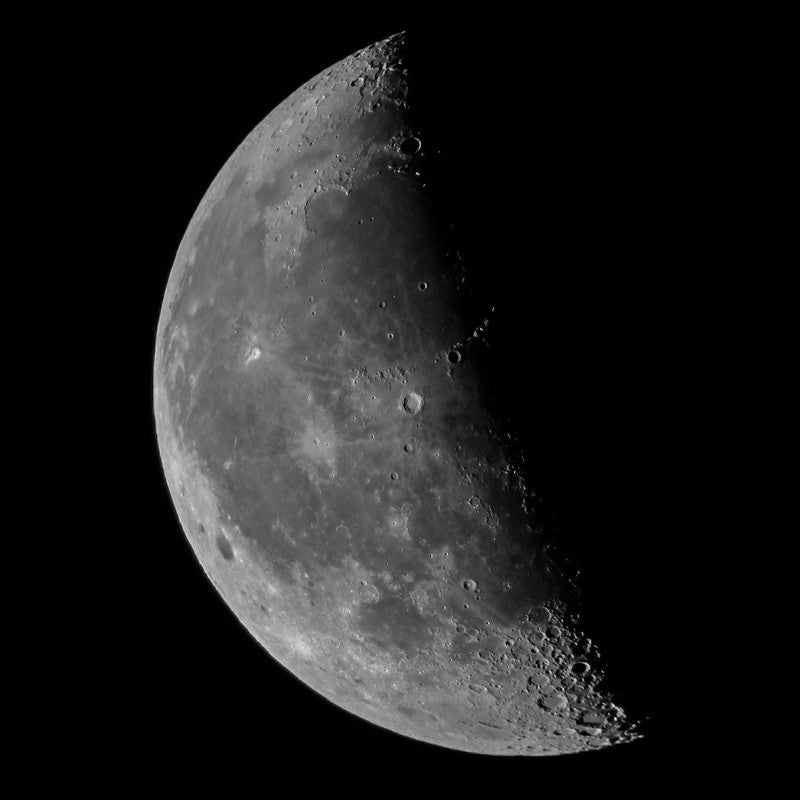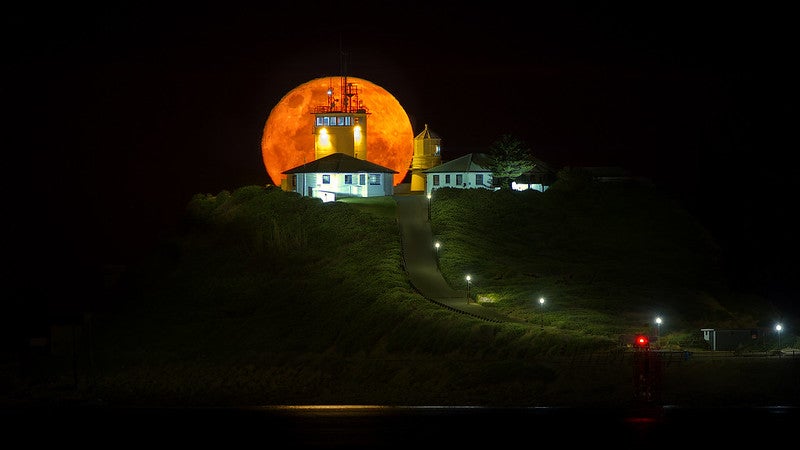
Friday, June 30
As darkness falls this evening, Cassiopeia the Queen is on the upswing in the north. This circumpolar constellation rotates around the North Celestial Pole, marked by Polaris at the end of the Little Dipper’s handle. Many observers can easily find Cassiopeia’s brightest stars, which form a distinct W shape in the sky.
The rightmost (western) dip in the W is the Queen’s alpha star, magnitude 2.2 Shedar. Less than 2° north-northeast of this star is magnitude 3.5 Achird, also cataloged as Eta (η) Cassiopeiae. Find it in your telescope and you’ll discover Eta is a binary system with a brighter yellow-white primary and a fainter orange secondary, standing about 11″ apart. That primary is stunningly Sun-like, just a little cooler than our own star, while its much dimmer companion puts out less than one-tenth our Sun’s light. Although discerning star colors can be challenging, the close proximity of these two stars reveals a striking color difference — what shades do you see?
These stars circle each other ever 480 years, with an average separation nearly twice that of Pluto’s from the Sun. They lie only about 20 light-years away, making them relatively close neighbors of our own Sun and solar system.
Sunrise: 5:35 A.M.
Sunset: 8:33 P.M.
Moonrise: 6:01 P.M.
Moonset: 2:42 A.M.
Moon Phase: Waxing gibbous (90%)
*Times for sunrise, sunset, moonrise, and moonset are given in local time from 40° N 90° W. The Moon’s illumination is given at 12 P.M. local time from the same location.
Saturday, July 1
Mercury reaches superior conjunction at 1 A.M. EDT, rendering it invisible due to its proximity to the Sun. Don’t worry, though — the solar system’s speediest planet will reappear in the evening sky before the end of the month.
Neptune stands stationary amid the stars of Pisces the Fish at 9 A.M. EDT. You can find it in the early-morning sky, rising about half an hour after midnight and climbing above an altitude of 30° in the southeast in the two hours before sunrise. It’s best to catch it while the sky is still mostly dark, as its faint magnitude 7.7 glow requires binoculars or a telescope to spot. The distant ice giant’s disk is just 2″ wide, but its slightly circular, “flat” appearance should help you identify it among the pinpricks of background stars.
Neptune currently lies about 7° below (south-southeast) of the Circlet of Pisces, an asterism containing 7 stars in far western Pisces. Even farther below Neptune (20° south-southeast) is 2nd-magnitude Diphda, also known as Beta (β) Ceti or Deneb Kaitos. This three-solar-mass star is one of the brightest nearby X-ray stars, though astronomers don’t completely understand how it generates them.
Sunrise: 5:35 A.M.
Sunset: 8:33 P.M.
Moonrise: 7:16 P.M.
Moonset: 3:22 A.M.
Moon Phase: Waxing gibbous (95%)
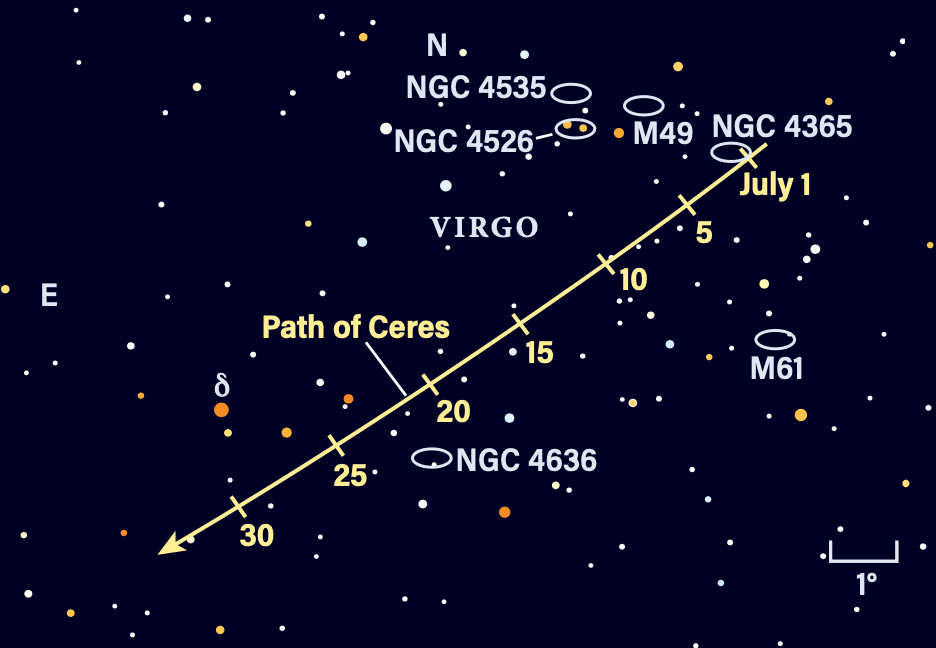
Sunday, July 2
Let’s catch dwarf planet 1 Ceres as it skims less than half a degree due south of elliptical galaxy NGC 4365 in Virgo.
First, we’ll start by finding magnitude 8.8 Ceres — it’s located about halfway on a line drawn between magnitude 2.1 Denebola at the tip of Leo’s tail and magnitude 3.4 Delta (δ) Virginis. You can also use 4th-magnitude Omicron (ο) Virginis to locate the dwarf planet, which is about 5° southeast of this star.
Once you’ve found Ceres, you don’t need to look far to spot the fuzzy glow of NGC 4365. Ceres lies ¼° due south of this galaxy, which is part of the huge Virgo Cluster of galaxies dominated by M87, about 5.3° north-northeast of NGC 4365. That larger elliptical is also brighter, around magnitude 8.6, and will show up better than NGC 4365 through smaller apertures. Plenty of other galaxies populate this area as well, so you may run into several as you scan around with your telescope or binoculars. Larger optics will net you more galaxies, especially as Virgo is slowly setting and the Moon is lighting up the sky.
Ceres will continue to move slowly though Virgo for the rest of the month, offering a great jumping-off point to explore the many extragalactic sights to be found here.
Sunrise: 5:36 A.M.
Sunset: 8:32 P.M.
Moonrise: 8:25 P.M.
Moonset: 4:13 A.M.
Moon Phase: Waxing gibbous (99%)

Monday, July 3
Full Moon occurs at 7:39 A.M. EDT, lighting up the sky as it rises in the east around sunset. July’s Full Moon is also called the Buck Moon, and this one is extra-special. It’s considered a Super Moon because the Full phase occurs when our satellite is within 90 percent of perigee, the closest point to Earth in its slightly egg-shaped orbit around our planet. The Moon will officially reach perigee tomorrow evening, when it will appear largest in the sky for the month.
There are three other Super Moons this year, all of which will appear at least slightly larger and brighter than this month’s, as they occur closer to the moment of perigee.
Given that the Moon will take center stage in the sky tonight, let’s check out some of its features. One of the most prominent is the large, bright crater Tycho, whose long, fingerlike rays spread far and wide from the point of impact in the Moon’s southern hemisphere.
Pull out your telescope and you’ll notice they even reach as far as the Sea of Serenity in the lunar northeast. Here, the bright rays are extra-visible as they cross the darker lava plains, telling us which came first. Explore the many smaller craters that pockmark Serenity’s flat floor and take note of how they interact with the material from Tycho’s rays. Here, too, the look of the region can reveal clues as to whether the ray or the crater was laid down first.
Observing the Full Moon through a telescope can be a bit of an eye-watering experience. If the light from your eyepiece is too bright, try putting in a Moon filter, slipping on some sunglasses before leaning in, or bumping up the magnification to show a smaller region of the lunar surface.
Sunrise: 5:36 A.M.
Sunset: 8:32 P.M.
Moonrise: 9:26 P.M.
Moonset: 5:17 A.M.
Moon Phase: Full
Tuesday, July 4
The Moon reaches perigee, the closest point to Earth in its orbit, at 6:25 P.M. EDT. At that time, it will stand 223,786 miles (360,149 kilometers) away.
There’s a short dark window tonight between sunset and moonrise — use it to try locating the famous Fireworks Galaxy (NGC 6946), which flies high in the eastern sky after sunset in far northern Cygnus. You can locate it by first centering on magnitude 3.4 Eta Cephei in nearby Cepheus the King, then slowly scanning about 2° southwest to find this faint spiral.
This 9th-magnitude spiral features a small, bright core and broad arms that actually do it a bit of a disservice. Because the galaxy spreads to 11′ by 10′ on the sky, its overall surface brightness is quite low, rendering those arms difficult to see. Opt for the largest telescope available to pull out the most detail, but smaller apertures will still show a smudgy, faint glow.
The Fireworks Galaxy is so named because it has hosted numerous supernovae over the years, appearing to pop off like celestial fireworks. As the Moon rises, its light will wash out the dark background sky and you’ll lose any contrast that might help you spot NGC 6946. If you miss your chance, just wait a few days for the Moon to move along and begin to wane — darker conditions will aid in locating this quarry.
Sunrise: 5:37 A.M.
Sunset: 8:32 P.M.
Moonrise: 10:14 P.M.
Moonset: 6:31 A.M.
Moon Phase: Waning gibbous (98%)
Wednesday, July 5
A few hours before sunrise, the mighty planet Jupiter hangs in the eastern sky, glowing at magnitude –2.2. You’ll find it in southern Aries, about 11° below magnitude 2.6 Sheratan.
Through a telescope, Jupiter’s Galilean moons are visible. To the west, Callisto sits farthest out, with Ganymede closer in. In the east, Europa sits farther from Jupiter; Io emerges from behind the planet’s eastern limb around 3:25 A.M. EDT and then continues east, moving farther out as the hours progress.
To Aries’ east, Taurus is also rising as dawn approaches. The Pleiades star cluster, a bright, easy-to-spot open cluster in the constellation’s western regions, appears first, leading the V-shaped head of the Bull. Anyone can enjoy the Pleiades without binoculars or a telescope. This grouping is also known as the Seven Sisters — do you see seven stars, or perhaps fewer or more? It can all depend on your visual acuity and the conditions of the sky. If you do opt to get a closer look with some optics, choose a low power to avoid zooming in too closely. Because the loosely packed cluster is nearby, it takes up a large area of the sky, stretching about 110′ across!
Sunrise: 5:37 A.M.
Sunset: 8:32 P.M.
Moonrise: 10:53 P.M.
Moonset: 7:52 A.M.
Moon Phase: Waning gibbous (93%)
Thursday, July 6
Let’s return to the early-morning sky to enjoy the solar system’s other gas giant: Saturn, the ringed planet. Magnitude 0.6 Saturn floats high in the south an hour before dawn, with the Moon appearing to the planet’s lower right (southwest). The Moon will pass 3° due south of Saturn later tonight at 11 P.M. EDT, though the pair will be below the horizon or just barely rising at that time.
This morning, while they’re still relatively far apart, home in on Saturn with a telescope to enjoy its stunning rings. Like Jupiter, Saturn is wreathed in moons, though only the brightest — 8th-magnitude Titan — will likely be readily visible, about 1′ to the planet’s northwest. Fainter moons Tethys, Dione, and Rhea are closer to the planet, with the former just southwest of the disk and the latter two located within 1′ or so to the east of the planet. But these three moons may be difficult to spot with the nearby Moon washing out the background sky.
Closer to the horizon in the south, you may also spot a lone bright star: That’s magnitude 1.2 Fomalhaut, a famous young star in the constellation Piscis Austrinus. Depending on your latitude, it may be difficult to see, lying close to the horizon. This star hosts a huge protoplanetary disk that has been intensely studied by astronomers for years.
Earth reaches aphelion, its farthest point from the Sun, at 4 P.M. EDT, when our planet will sit some 94.5 million miles (152 million km) from our star.
Sunrise: 5:38 A.M.
Sunset: 8:32 P.M.
Moonrise: 11:25 P.M.
Moonset: 9:11 A.M.
Moon Phase: Waning gibbous (85%)
Friday, July 7
Venus reaches greatest brilliancy, a stunning magnitude –4.7, at 10 A.M. EDT. It now dominates the western sky at sunset, sitting close to Mars and the star Regulus in western Leo the Lion. Venus slowly sets as darkness falls, disappearing below the horizon around 10:30 P.M. local daylight time, followed shortly by Mars. Through a telescope, Venus appears a large 37″ across but displays a crescent phase that is just 26 percent lit.
If you’ve been watching the evening sky, you’ll have noticed Venus approaching Mars as though it might catch up. However, Venus will never quite make it; rather than making it to Mars and Regulus, the planet will instead quickly start dipping down toward the horizon night by night within a few days.
Asteroid 15 Eunomia reaches opposition at 4 P.M. EDT. Eunomia now lies in Sagittarius, near the center of the Milky Way and located in the southern sky before dawn. However, because the bright Moon is also in that region, we’ll wait to check in with Eunomia for another few days to give our satellite time to move away.
Sunrise: 5:38 A.M.
Sunset: 8:31 P.M.
Moonrise: 11:52 P.M.
Moonset: 10:28 A.M.
Moon Phase: Waning gibbous (76%)

Sky This Week is brought to you in part by Celestron.


